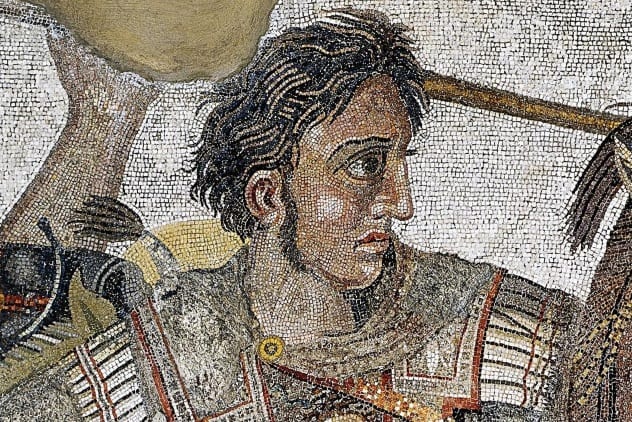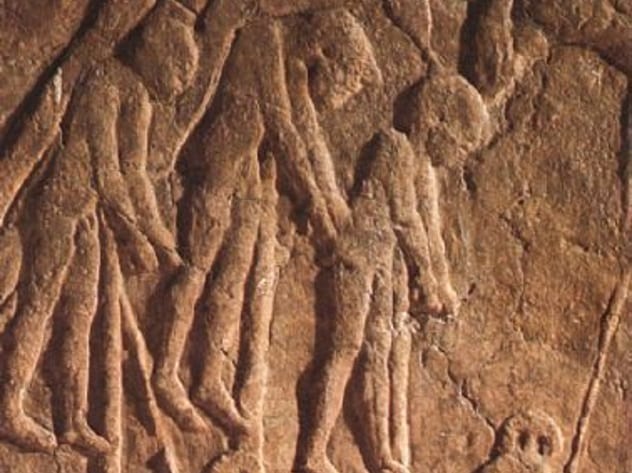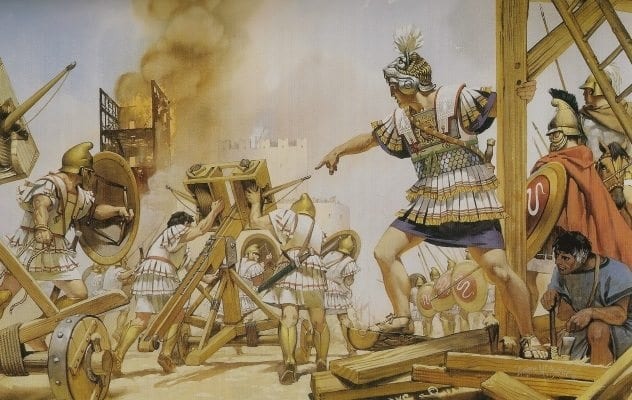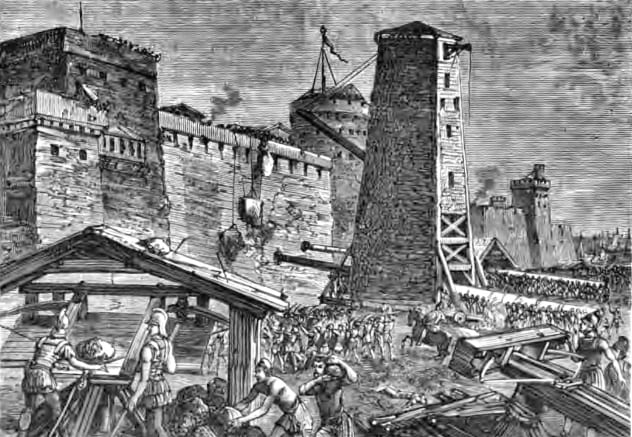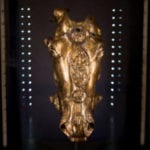Psychological warfare is a blend of propaganda and actual tactics that can create a firestorm of terror in the mind of the enemy, long before the first arrow is shot or the first bomb is dropped. Carl von Clausewitz remarked in his work On War that the goal of warfare is to disarm the enemy and make them submit to the will of those conducting the war.[1] Sometimes, through the use of psychological warfare, this can happen easily, without a fight. Long before the use of newspapers and digital media, cultures had to conduct psychological warfare using more organic and rudimentary tools, the only things that they had at their disposal at the time. Here are ten brutal methods of psychological warfare from the ancient world.
10 Occupation
Alexander the Great employed psychological warfare in ways that were quite novel at the time, and the results were outstanding, as the massive empire he forged shows us. What most people think about when they think of psychological warfare is purely intimidation, but as von Clausewitz said, all warfare is political. Alexander used a new tactic that he invented to expand his empire, one the Romans would later use as they became a powerful military force, and that tactic contained a beautiful mixture of friendly alliances and intimidation. See, before Alexander, military leaders would march through a city, plunder the goods, often execute the men and keep the women, and then burn it to the ground. Alexander changed this by leaving a certain amount of his troops and forces behind, leaving the cities standing, and making friends with the social elites of each conquered culture so that those defeated foes could then adopt Greek culture and become assimilated into the empire.[2] The tactic relied on political genius, mutual friendliness, and, of course, the implied threat of having a very powerful group of soldiers occupying your hometown that could smother any dissent that came about. Alexander’s brutal method was occupation, and while it was sometimes friendly on the surface, imagine the soldiers of a foreign nation standing on your street corners, in your homes, forcing you to adopt their ways at the threat of killing you. This tactic wasn’t all nice—it was more deeply psychologically disturbing.
9 Timing
Cyrus the Great was a military leader and conqueror who would rise to become the leader of the Achaemenian (or Achaemenid) Empire, also known today as the Persian Empire. Initially, Cyrus conquered many local cities in the area of modern-day Iran, and then he set his sights on a bigger prize—the city of Babylon—and he successfully took it by employing psychological warfare. Cyrus showed through psychological warfare that if you show up at just the right time, you can win a war and claim a city with a minimal fight. Cyrus waited until things were ripe in Babylon, an ancient city with very powerful and respected priests, who the nation’s leader, Nabonidus, had seriously pissed off right before Cyrus showed up.[3] The Babylonians had come to believe that their leader had disowned their major god, Marduk. The priests of the Babylonian religion saw this as a major transgression, and to top all of this off, Nabonidus had been on a military conquest for 11 years, hoping to control and dominate trade routes in the area. It seems he’d been gone for so long that his own people began to dislike him, though he’d left his son in his place to hold down the fort. Cyrus not only capitalized on this but had instigated it all along, sending representatives into the city to slowly spread propaganda until the people were totally fed up with their king. This process took years. When the timing was right, Cyrus showed up and won over the already angry, elite class of the priests of Babylon and turned them against their leader. He was also able to make nearby armies who had sworn alliances to Babylon defect and join the fight against Nabonidus. Together, these smaller towns helped Cyrus in his campaign as his Persian army rolled through the ancient city.
8 Political Clout
When it comes to a shining, lovable, political image put forth by a political and/or military leader, very few, if any, people in history come close to the political savvy displayed by Julius Caesar. From the First Triumvirate to the treatment of the Gallic tribes north of Rome at the time, Caesar was a master manipulator in the name of furthering his political and military aspirations.[4] The Celtic warriors of Gaul had conquered the city of Rome after laying siege to it in 390 BC. Now, in 58 BC, Caesar wanted payback after centuries of skirmishes between the loose-knit band of ethnically and culturally similar tribes that composed the unofficial nation of Gaul, and he got it by starting with a smile. Initially, Caesar was trying to attack a nearby resource-rich nation and not actually Gaul, though Gaul was always on the back burner. At first, Caesar took it upon himself to go make friends with the Gallic tribes in the area. He became well-liked among the local tribes and was welcome in the area. But little did the Gauls know that Caesar was planning on totally dominating the unofficial nation at a later point. By 52 BC, the Gauls had grown weary of Caesar, and a lot of the tribes turned against Rome, eventually culminating in an attack by the Belgian Gauls from the north, who would consolidate Gallic military might and lead a charge against the expanding Rome. But Caesar had already been perfecting his strategy for years—his plan was laid out, and his Roman legions crushed the Gauls and pushed them far back into the territories of Northern and Western Europe.
7 Impalement
It’s quite obvious how a mass of impaled human bodies might intimidate and dissuade an invading army, making it reconsider its effort in your territory. Even if it did not, it would serve to strike fear into the hearts of the combatants who sought to conquer your land and take your riches. Thousands of years before Vlad the Impaler came on the scene, there was Assyria. Assyria was unanimously agreed upon as a violent culture, something that’s even mentioned in the Holy Bible. Ancient depictions show us that the Assyrians not only used to impale people like Vlad did, but they took it a step further by stabbing the stake through the victim’s abdomen.[5] All this would leave a grisly and horrifying sight for any passersby who might have considered taking on the ancient Assyrians. This no doubt terrified both criminals and foreign armies alike.
6 Gifts Of Flesh
When it comes to psychological warfare in the form of sheer brutality, impalement wasn’t the only thing the ancient Assyrians turned to—they had other methods of scaring the life out of their neighbors. Ashurbanipal was the king of Assyria from 668 to 627 BC, and he was apparently quite gifted intellectually. Ashurbanipal would use his intellect sometimes for torturous ploys which would turn out to be genius military strategies. See, Ashurbanipal seemed to take tremendous joy in removing the flesh of his victims and rivals, but he did this for a calculated reason—to terrify others. He is quoted as saying, “I will hack up the flesh and then carry it with me, to show off in other countries.”[6] Can you imagine the looks on the faces of today’s leaders if one nation’s highest chief met with another toting a bag of well-preserved flesh which had been systematically carved off his enemies? Needless to say, the message was loud and clear.
5 Flaying And Staking
Another notable tactic of highly intimidating psychological warfare from ancient Assyria, the real ancient kings of brutality, was called flaying and staking. Flaying and staking is mentioned in the Holy Bible, and other surviving works depict this gruesome process, which was a horrific style of execution in the name of intimidation. It began with flaying the offender, usually a provincial governor of a conquered territory who refused to bow to the mighty Assyrian rule. The Assyrians would skin the person alive but not quite until death, just enough to make them suffer and to gather enough skin to place around the walls of wherever they were in order to scare off any rival armies. Staking was similar to impalement, but the executioner would slowly shove the stake up through the anus of the condemned, taking great care to only move the vital organs aside so as to not kill the offender.[7] Then, in traditional impalement-like fashion, they would sometimes hoist the stake up by burying the butt end of it into the ground to put on display before their cities. The reason for the tedious process was to keep the person alive as long as possible, and sometimes, these poor condemned persons would live for several days on end.
4 Crucifixion
Crucifixion could almost be likened to cultures erecting skyscrapers of their enemies, both living and dead, to stand tall and tower, terrifying their enemies and potential adversaries—such a sight of a group of crucified, helpless victims would be enough to make anyone reconsider a challenge to the people doing the crucifying. Crucifixion was actually pretty widespread throughout the ancient world. The Persians, the Carthaginians, and other cultures practiced it as both a military and criminal deterrent. There were many different methods of crucifixion to terrify an enemy with, and some cultures used various versions of the practice over time. In Rome, for instance, nails weren’t always driven through the intended victim, so as to prolong the suffering in the air rather than risk the offender bleeding to death.[8] In these cases, the victim would be simply tied to the cross or T-shaped wooden crucifix. Then the bones would be bent and misshaped and often broken to increase suffering, and the victim would be erected into the air for all to see. Many people died slowly as birds ate their flesh over a series of days. Nails were also employed in various ways. Sometimes, the victim would have their legs bent around the sides of the wooden log, and then the nail would be driven through the side to fasten the legs in a much more uncomfortable position than the one we’re most familiar with. When nails were used on the upper body and driven through the arms, the weight of the body would cause the shoulders and other bones to break or dislocate, further adding to the pain of the condemned. This definitely scared away many of far-off armies who may have sent a traveler abroad and also made occupied cultures think twice about an insurrection.
3 Siege
Siege warfare relied on extremely powerful psychological tactics to force the enemy into submission. Siege warfare still remains a potent tool in the military commander’s toolbox that is often dug out even today. A war of attrition is where the forces of one military attempt to wear down the forces and supplies of another army and has long been a very powerful weapon, trading a quick conquest for the slow and certain collapse of decay. The side with the greatest access to resources over time intentionally prolongs the war to wear down the other side’s supplies. Laying siege to a city often meant surrounding it in the form of a blockade, to cut off all supplies inbound and outbound, and then simply waiting . . . slowly waiting . . . for the enemy within the city limits to burn through all of their available resources, such as food and fresh water.[9] As people began to slowly starve and resemble skeletons, they more often than not became much more willing to negotiate a peaceful solution, and if they wanted to fight, their weakened, starved armies didn’t pose a very serious threat. In the most extreme of cases, cities under siege often turned to cannibalism as a last resort if their leaders refused to concede to the army surrounding them. The psychological effects of such tactics are as obvious as they are terrifying. From beginning to end, the Romans were the masters of siege warfare in ancient times, starting with the Siege of Veii, a city which belonged to their culturally similar yet long-rivaled neighbors to the north, the Etruscans. After being beaten in many fights, the infant Roman nation fortified their army and moved to lay siege to Veii in 405 BC. They successfully implemented a long siege but were pushed back in 402 BC by reinforcements and continued their stronghold nearby. It should be noted here that siege warfare back then took a long time—a very long time. In 396 BC, after years of siege, the Romans devised a plan to take the weakened city and dug under the walls that surrounded it and took it from within. This was the beginning of many Roman sieges laid upon the ancient world, with devastating results for anyone and everyone on the receiving end.
2 The Helepolis
And then there came the Helepolis—the taker of cities. This ancient marvel was a terrifying sight to behold, a massive, mobile tower that could effectively take any city by giving the persons on board a higher vantage point from which to fight downward while they climbed over the walls of the enemies they fought. This mobile skyscraper would be rolled into battle on its eight wheels by hand, pushed slowly and intently toward the enemy. Imagine that it’s the fourth century BC, and suddenly, approaching upon the horizon, you see the largest chariot you’ve ever seen, the size of a modern-day high-rise building, slowly creeping toward you as you hold out at your fortification. The terrifying sight must have been an absolute nightmare to behold, as those on the receiving end of the slow-moving Helepolis knew their city walls that they’d relied on their entire lives were absolutely useless. The Greeks made more than one siege tower over the years, but the Helepolis was the grandest of all, with an iron exterior that couldn’t be set on fire like other siege towers, but it ultimately proved a failure in the Siege of Rhodes in 305 BC.[10] At 40 meters (130 ft) tall and 20 meters (65 ft) wide, the Helepolis was a behemoth, but as it approached Rhodes, the people inside the city had a genius idea. Using the cover of night, they built a large pool of mud and sewage near where they thought the Helepolis was likely to make its assault—and they were exactly right. The massive machine ended up becoming stuck and was eventually abandoned.
1 The Brazen Bull
The brazen bull was a torture device used in ancient Greece. (Note that some historians believe its existence was a tall tale; others say there is sufficient evidence that it was real.) The ancient Greeks didn’t often venture into the outside world to conquer aside from Alexander the Great, a period of unification, as the various city-states were typically fighting among themselves. The brazen bull was developed in the sixth century BC for the ruler Phalaris as a method for executing criminals, all while sending a clear and tyrannical signal to any would-be rivals. Perillos of Athens was the man who invented it, creating a brass bull that had a striking resemblance to the real thing.[11] This brass bull was hollow on the inside, with an opening in the side of it that could be shut and locked from the outside. The carved out nostrils and mouth were the only ventilation from the inside of the bull. After someone was convicted and condemned, they would be placed inside the bull, and a fire would be set beneath it. Because metal transmits heat quite well, the brass would heat up and cook the person inside alive. The screams and cries of the condemned surely sent a clear message—don’t mess with Phalaris. In a stunning betrayal, when Perillos of Athens presented the brazen bull to Phalaris, the king decided that Perillos would be the very first man that the bull would be tested on. Perillos was placed inside the bull but was taken out before he died. This wasn’t a reprieve, though; Phalaris is said to have then thrown Perillos off a hill. In the end, however, the people of Athens, who had long been subjected to Phalaris’s cruelty, became tired of the tyrannical ruler and turned against him, killing him with nothing other than the brazen bull. I like to write about the dark, the deranged, the twisted, history, true crime, and macabre stuff.
